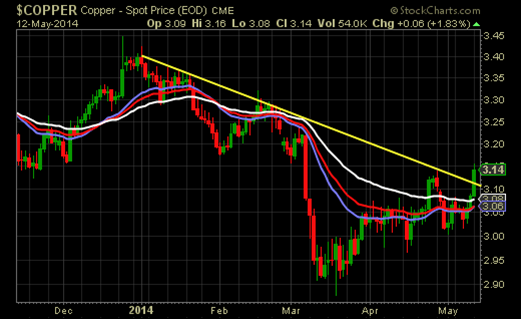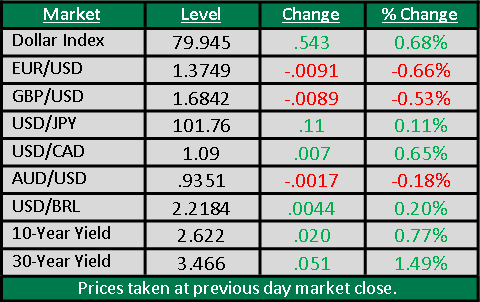Archive for month: May, 2014
Your Weekly Economic Cheat Sheet 5.19.2014
/in Investing/by Tom 2Last Week
The economic data last week became a bit of a Rorschach (ink blot) test. Depending what camp you’re in (bull or bear), you could see last week’s data as supporting your case. But, that aside, the takeaway is that nothing last week changed anyone’s expectations for economic growth domestically or internationally.
For the bears, April industrial production and retail sales both missed estimates. By themselves those data points weren’t that consequential, as they weren’t big misses. But, they were disappointing because they imply that the strong gains we saw in the economy in February and March were just part of a “bounce back” effect from the weather-related drop in December/January. And, now that the “bounce back” is over, we’re returning to the recent norm — data that imply 2% GDP growth, not 3% (which is what everyone expects and the stock market needs). So, the IP and retail sales data were taken to potentially mean we’re not seeing a sustained acceleration in economic activity.
For the bulls, while the April data were disappointing, the May data released last week were strong, implying the economy is picking up speed again. The Empire State and Philly Fed manufacturing surveys (the first two May economic releases) both beat estimates, with Empire State coming in at 19.01 vs. (E) 5.0, and Philly registering 15.4 vs. (E) 14.3. Additionally, jobless claims fell below the 300K mark (297K) for the first time since September (and only the second time for the recovery). So, the current data imply we are seeing re-acceleration in the economy.
On balance, I’d say last week went in the bears’ favor, as investors and analysts remain very, very skeptical regarding the U.S. economy’s ability to reach “escape velocity” and finally move toward 3%+ GDP growth.
That’s important because if the bears are right (and data last week does not make them right) and the economy does indeed return to the recent “new normal” of 2% GDP growth annually (and not the expected 3%), then the stock market is extended and will correct.
So, this remains an economy that is short on confidence. Despite current data coming in strong, until we see a more-extended trend, the benefit of the doubt will remain with the bears (but again, that doesn’t mean they are right).
In Europe, the big surprise last week was the weak Q1 GDP report (they can’t blame the weather). Q1 GDP was just 0.2% quarter-over-quarter vs. (E) 0.4%, and year-over-year was 0.9%.
That’s a touch weaker than the market expected (the market is expecting a little over 1% this year from the EU, so this stoked some fears about a slower than expected EU economy). But, the focus remains more on the ECB and what they’ll do next, so this one number didn’t really change the outlook.
This Week
There’s not a lot of data this week, but Wednesday night and Thursday will be important, especially given the context of the economic confidence problem we seem to have.
Wednesday/Thursday bring the May flash manufacturing PMIs, with China coming Wednesday night and the EU and U.S. Thursday morning. Again, the confidence problem isn’t limited to the U.S. There are ongoing concerns about EU growth given the soft Q1 GDP print, and obviously China remains (and will remain) an ongoing concern. So, if these flash PMIs can meet expectations or even beat, that will provide a nice confidence boost for the global economy.
Outside of the flash PMIs, the minutes from the April Fed meeting are released Wednesday, although I don’t think there will be too much revealed in those minutes (perhaps some discussion on inflation and how/when to continue to exit QE, but the policy outlook for the Fed shouldn’t change). Staying with the Fed, Chair Janet Yellen speaks Wednesday. But it’s at the NYU commencement, so I doubt there will be any revelations about monetary policy.
Finally, housing will remain in focus. The housing starts number last Friday looked a lot better than it actually was, so the market remains focused on seeing housing rebound from the winter dip like the other parts of the economy. Existing home sales come Thursday morning, while new home sales come Friday.
Bottom line: This week won’t definitively alter the outlook for the global economy, but given the continued strength in the bond market (and the potential signal it is sending), strong flash manufacturing PMIs will help give investors a badly needed boost of confidence.
Sevens Report Analyst Tyler Richey Featured on MarketWatch.com Discussing Precious Metals and Energy Futures
/in Investing/by Tom 2Your Weekly Economic Cheat Sheet 5.12.2014
/in Investing/by Tom 2Last Week
With the exception of the ECB, it was more of the same last week as economic data from the U.S., the EU and China confirmed what the market currently assumes and has priced in. Those assumptions are that: U.S. growth is recovering from the temporary winter drop, and 3% annual GDP growth is consensus. The EU economy is seeing the recovery accelerate slowly (but overall economic growth remains weak). Economic growth in China is showing signs of stabilizing (so 7.0%-7.5% GDP growth is still to be expected).
Looking at last week’s data, reports were light in the U.S., but as mentioned, the reports we did get were good.
ISM non-manufacturing PMI was 55.2, the best reading since August, and that strong data helped reverse a big decline (over 100 points) last Monday in the Dow.
Additionally, weekly jobless claims declined to 319K, and appear to have resumed the downtrend we were seeing prior to the Easter/Spring Break “noise” in the number. And, if that trend of lower claims continues, it’ll continue to imply we’re seeing incremental improvement in the labor market (obviously a positive for the economy).
The Yellen testimony in front of Congress was in focus last week. But while some in the media were trying to spin her comments as a slight downgrade on the outlook for the economy, they really weren’t. Her comments didn’t give anyone any reason to change their outlook for Fed policy (tapering ending October/December, with the first interest rate hike coming in mid-2015).
In China, composite PMIs were in-line (importantly the service sector PMI stayed above 50 at 51.4). Meanwhile, the April trade balance was the positive surprise of the week, as both exports and imports increased small vs. expectations of a 3% monthly drop for both.
We get more Chinese data this week, but if it can confirm what we saw last week, it would make a very good case that the Chinese economic growth pace is stabilizing. (This is important because we may be able to get long “China” and also because it’ll remove the macro risk of a Chinese “hard landing.”)
The “biggest” event of the week was the ECB meeting last Thursday. As expected, there was no change to policy, but ECB President Mario Draghi’s comments during the Q-and-A (he stated that the Committee was “comfortable acting next time”) commanded the market’s attention.
We knew Draghi would again try to rhetorically ease policy, but no one expected this amount of specificity. And, it worked. The euro collapsed late last week, and everyone is penciling in either a rate cut in June, or the introduction of negative deposit rates. (QE, however, remains well off in the future.)
This Week
This is a busy week of data on the calendar, but I don’t expect any of it to materially change the market’s economic assumptions about the U.S., EU or China, unless the numbers are simply horrid.
In the U.S., retail sales tomorrow are the highlight, followed by industrial production Thursday. Although economic data have been strong, the inexplicable strength in the bond market and U.S. dollar weakness are keeping concerns alive about growth going forward. So, to a point, the market has a confidence problem, and each number that comes in better than expected (especially in April) helps to re-affirm that the economy is indeed seeing the recovery accelerate. So, retail sales and IP are important from a confidence standpoint.
We also get the first look at economic activity in May, via the Empire State and Philly Fed reports (both Thursday). These two first looks have lost some significance now that flash PMIs are released for the U.S. (they come next Thursday), but still they are watched because it’s the first data for the current month. Philly has been the better predictor of national manufacturing activity lately, so pay more attention to that one.
Internationally, China releases April retail sales and industrial production tonight, and again the market is looking for further signs of stabilization. In Europe there are several pieces of data, but again unless the news is horrid, it won’t really change anything as the entire focus of Europe is on what the ECB will do at the June meeting.
Address
4880 Donald Ross Rd., Suite 210
Palm Beach Gardens, FL 33418
info@sevensreport.com
Phone
(561) 408-0918


